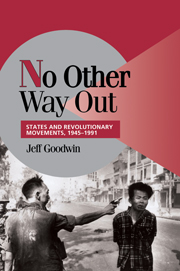Book contents
- Frontmatter
- Contents
- Figures, Tables, and Maps
- Abbreviations and Acronyms
- Preface and Acknowledgments
- Part 1 Introduction
- Part 2 Southeast Asia
- Part 3 Central America
- Part 4 Further Comparisons and Theoretical Elaborations
- 7 BETWEEN SUCCESS AND FAILURE: PERSISTENT INSURGENCIES
- CHRONOLOGY FOR EASTERN EUROPE
- 8 “REFOLUTION” AND REBELLION IN EASTERN EUROPE, 1989
- 9 CONCLUSION: GENERALIZATIONS AND PROGNOSTICATION
- Annotated Bibliography
- Index
- Titles in the series
8 - “REFOLUTION” AND REBELLION IN EASTERN EUROPE, 1989
Published online by Cambridge University Press: 05 June 2012
- Frontmatter
- Contents
- Figures, Tables, and Maps
- Abbreviations and Acronyms
- Preface and Acknowledgments
- Part 1 Introduction
- Part 2 Southeast Asia
- Part 3 Central America
- Part 4 Further Comparisons and Theoretical Elaborations
- 7 BETWEEN SUCCESS AND FAILURE: PERSISTENT INSURGENCIES
- CHRONOLOGY FOR EASTERN EUROPE
- 8 “REFOLUTION” AND REBELLION IN EASTERN EUROPE, 1989
- 9 CONCLUSION: GENERALIZATIONS AND PROGNOSTICATION
- Annotated Bibliography
- Index
- Titles in the series
Summary
When they saw so many ridiculous, ramshackle institutions, survivals of an earlier age, which no one had attempted to co-ordinate or adjust to modern conditions and which seemed destined to live on despite the fact that they had ceased to have any present value, it was natural enough that thinkers of the day should come to loathe everything that savored of the past and should desire to remold society on entirely new lines. …
– Alexis de Tocqueville (1955 [1856]: 140)De Tocqueville called the French Revolution history's largest property transaction; but the legacy of 1789 is easily matched by the privatization that followed 1989.
– Harold James (1997: 6)If one set out in the spring of 1980 to analyze recent revolutions – inspired, perhaps, by the dramatic events of the previous year in Iran, Nicaragua, and Afghanistan – one's attention would have been drawn inexorably and indeed exclusively to the Third World. At that time, certainly, there did not seem to be anything particularly revolutionary occurring in the “Second World” of the Soviet bloc (and certainly not in the “First World” of advanced capitalist societies). Indeed, opposition movements in Eastern Europe seemed extraordinarily weak or simply nonexistent. The fact that powerful movements within and without the ruling Communist parties had been bloodily suppressed by the Soviet Union in Hungary in 1956 and rather more easily, but no less thoroughly, in Czechoslovakia in 1968 only underscored the apparently insurmountable difficulties in opposing the extant Communist regimes.
- Type
- Chapter
- Information
- No Other Way OutStates and Revolutionary Movements, 1945–1991, pp. 256 - 288Publisher: Cambridge University PressPrint publication year: 2001



